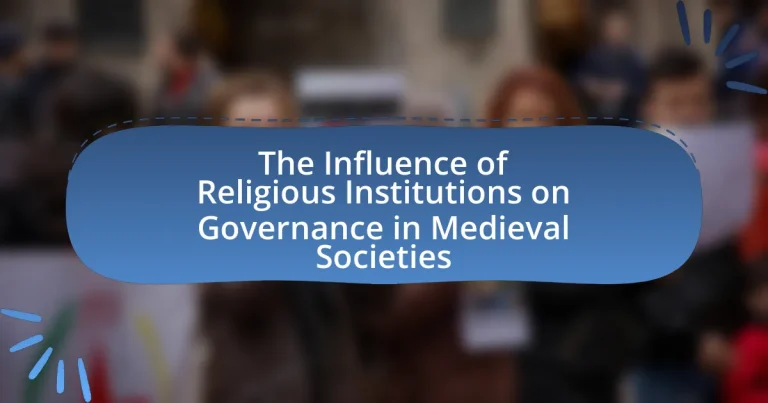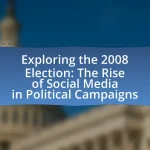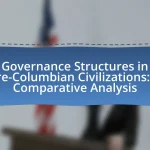The article examines the significant influence of religious institutions, particularly the Catholic Church, on governance in medieval societies. It outlines how these institutions intertwined spiritual authority with political power, shaping laws, societal norms, and the legitimacy of rulers through practices such as divine right and canon law. Key events, such as the Investiture Controversy, illustrate the conflicts between religious and secular authorities, while the roles of various churches and monastic orders highlight regional variations in governance. The article also discusses the long-term effects of this influence on modern governance structures and the lessons contemporary societies can learn from historical church-state relationships.
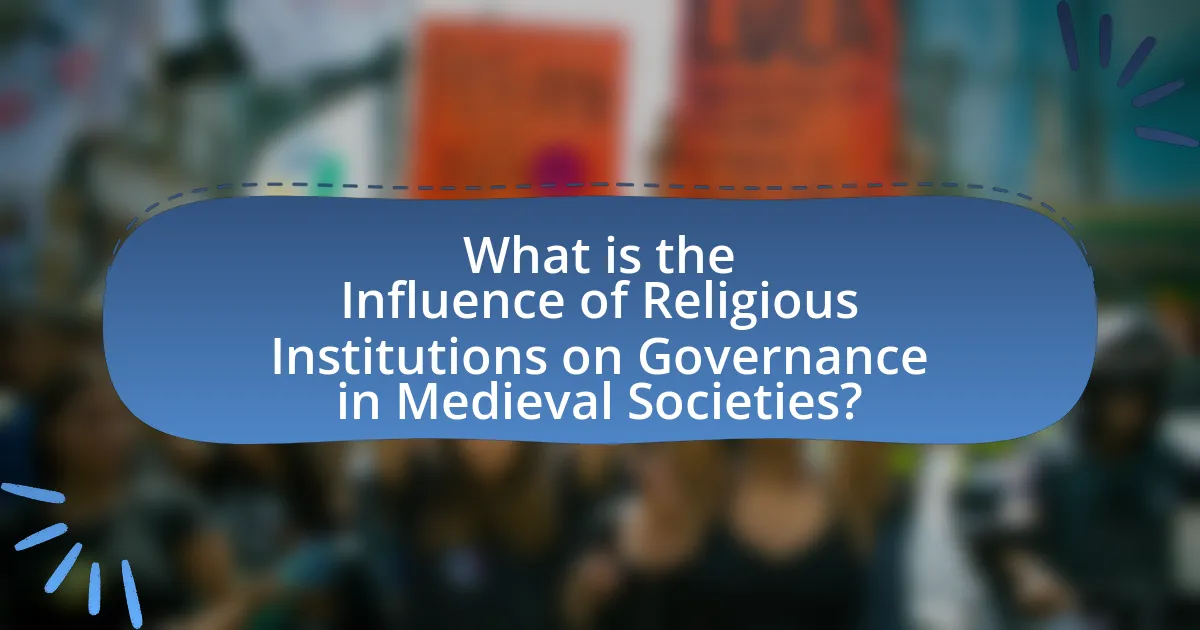
What is the Influence of Religious Institutions on Governance in Medieval Societies?
Religious institutions significantly influenced governance in medieval societies by intertwining spiritual authority with political power. The Church, particularly the Roman Catholic Church, held substantial sway over monarchs and local rulers, often dictating laws and moral standards. For instance, the Investiture Controversy in the 11th century highlighted the struggle between the papacy and secular leaders over the appointment of bishops, illustrating how religious authority could challenge and shape political governance. Additionally, religious institutions provided a framework for social order, as they established legal systems based on canon law, which governed not only spiritual matters but also civil disputes. This dual role of religious institutions as both spiritual and political entities reinforced their influence over governance, shaping the laws and societal norms of the time.
How did religious institutions shape political authority during the medieval period?
Religious institutions significantly shaped political authority during the medieval period by establishing moral and ethical frameworks that governed societal norms and legitimized rulers. The Catholic Church, for instance, wielded immense power, influencing kings and emperors through the concept of divine right, which asserted that monarchs derived their authority from God. This was evident in events such as the coronation of Charlemagne by Pope Leo III in 800 AD, which symbolized the Church’s role in legitimizing political power. Additionally, religious institutions controlled vast landholdings and resources, enabling them to exert economic influence over secular leaders. The Church’s ability to excommunicate rulers or place regions under interdict further demonstrated its capacity to challenge and shape political authority, as seen during conflicts like the Investiture Controversy, where popes and kings vied for control over appointments of bishops and abbots.
What roles did the Church play in legitimizing rulers?
The Church played a crucial role in legitimizing rulers by providing divine sanction and moral authority to their reigns. This was evident in the practice of anointing kings during coronation ceremonies, which symbolized God’s approval of the ruler’s authority. For instance, the coronation of Charlemagne by Pope Leo III in 800 AD not only established Charlemagne as the Emperor of the Romans but also reinforced the idea that his power was granted by God. Additionally, the Church influenced public perception through its teachings, asserting that disobedience to a ruler was tantamount to disobedience to God, thereby discouraging rebellion and promoting stability within the realm. This intertwining of religious endorsement and political power was fundamental in shaping governance during medieval times.
How did religious leaders influence the decision-making processes of monarchs?
Religious leaders significantly influenced the decision-making processes of monarchs by serving as advisors and legitimizers of royal authority. Monarchs often relied on the moral and spiritual guidance of religious figures to justify their rule and decisions, as seen in the divine right of kings doctrine, which posited that monarchs were chosen by God. For instance, in medieval Europe, the Pope held substantial power to excommunicate rulers, which could undermine their authority and sway public opinion against them. This was evident during the Investiture Controversy, where the conflict between Pope Gregory VII and Emperor Henry IV highlighted how religious leaders could challenge and influence political power. Additionally, religious institutions controlled vast resources and land, allowing them to exert economic influence over monarchs, further intertwining governance with religious authority.
What were the key religious institutions involved in governance?
The key religious institutions involved in governance during medieval societies included the Catholic Church, the Eastern Orthodox Church, and various local religious orders. The Catholic Church, particularly the Papacy, wielded significant political power, influencing monarchs and shaping laws through canon law. The Eastern Orthodox Church played a similar role in Byzantine governance, where the Emperor was seen as God’s representative on Earth, intertwining church and state. Additionally, local religious orders, such as the Benedictines and Franciscans, contributed to governance by managing lands, providing education, and serving as mediators in local disputes, thereby reinforcing the church’s authority in civil matters.
Which major churches and sects were prominent in medieval governance?
The major churches and sects prominent in medieval governance were the Roman Catholic Church, the Eastern Orthodox Church, and various sects such as the Cistercians and Franciscans. The Roman Catholic Church held significant power, influencing kings and political decisions through its hierarchy and the papacy, which asserted authority over secular rulers. The Eastern Orthodox Church similarly played a crucial role in governance in Eastern Europe, particularly in the Byzantine Empire, where the church and state were closely intertwined. Additionally, monastic orders like the Cistercians and Franciscans contributed to governance by providing education, social services, and moral guidance, thereby shaping local and regional politics.
How did monastic orders contribute to political stability?
Monastic orders contributed to political stability by serving as centers of education, agriculture, and social welfare, which helped to maintain order and support local economies. These institutions often acted as mediators in conflicts, providing a neutral ground for dispute resolution, which reduced violence and fostered peace. For example, during the medieval period, monasteries like Cluny in France played a significant role in promoting peace through the Peace of God movement, which sought to limit violence among the nobility. Additionally, monastic orders accumulated wealth and land, which they used to influence local and regional politics, often aligning themselves with powerful lords to stabilize governance. Their involvement in charitable activities also helped to alleviate poverty, reducing social unrest and contributing to a more stable society.
What conflicts arose between religious institutions and secular authorities?
Conflicts between religious institutions and secular authorities primarily revolved around issues of power, authority, and governance. For instance, during the Investiture Controversy in the 11th and 12th centuries, the Catholic Church and the Holy Roman Empire clashed over the appointment of bishops, with Pope Gregory VII asserting that only the Church had the authority to appoint church officials, while Emperor Henry IV sought to maintain secular control over these appointments. This conflict exemplified the broader struggle for dominance between spiritual and temporal powers, leading to significant political and social ramifications, including the eventual Concordat of Worms in 1122, which sought to resolve these tensions by delineating the roles of church and state in appointments.
What were the causes of power struggles between the Church and the state?
The power struggles between the Church and the state were primarily caused by conflicting interests over authority and governance. The Church sought to maintain spiritual supremacy and influence over moral and ethical matters, while the state aimed to assert political control and sovereignty. Historical events, such as the Investiture Controversy in the 11th century, exemplified these tensions, where monarchs and popes clashed over the appointment of bishops, highlighting the struggle for control over religious and political appointments. Additionally, the Church’s ability to excommunicate rulers and influence public opinion further intensified these conflicts, as seen during the reign of King Henry IV of Germany, who faced significant challenges due to papal opposition.
How did these conflicts impact governance and society?
Conflicts in medieval societies significantly impacted governance and society by altering power dynamics between religious institutions and secular authorities. The struggle for control often led to the establishment of theocratic governance models, where religious leaders wielded substantial political power, as seen in the Investiture Controversy, which highlighted the tension between the papacy and monarchies. This conflict resulted in the Church gaining influence over state matters, shaping laws and societal norms according to religious doctrine. Additionally, societal divisions emerged, as differing religious factions often led to civil unrest and violence, exemplified by the Crusades, which not only mobilized armies but also redefined social hierarchies and community structures. These conflicts ultimately reinforced the intertwining of governance and religion, creating a legacy that influenced future political systems.
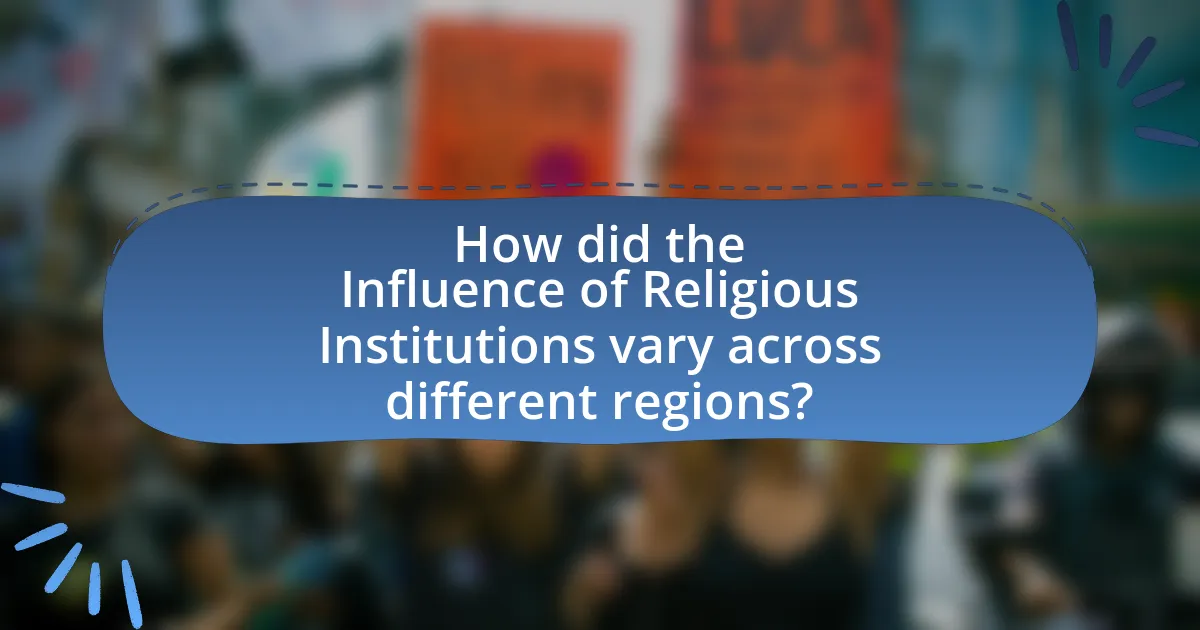
How did the Influence of Religious Institutions vary across different regions?
The influence of religious institutions varied significantly across different regions during medieval times, primarily shaped by local cultures, political structures, and historical contexts. In Western Europe, the Catholic Church wielded substantial power, often intertwining with monarchies, as seen in the Papal authority over kings, exemplified by the Investiture Controversy in the 11th century, which highlighted the struggle between church and state. Conversely, in the Byzantine Empire, the Orthodox Church maintained a close relationship with the state, where the emperor was seen as God’s representative on Earth, leading to a unique integration of religious and political authority. In Islamic regions, religious institutions like the caliphate played a central role in governance, with leaders often viewed as both political and spiritual authorities, as demonstrated by the Umayyad and Abbasid caliphates, which combined religious leadership with administrative control. In contrast, regions such as Scandinavia experienced a gradual Christianization process, where local chieftains adopted Christianity to consolidate power, leading to a more fragmented influence of religious institutions. Thus, the regional variations in the influence of religious institutions were shaped by the interplay of local governance, cultural practices, and historical developments.
What were the differences in the role of the Church in Western Europe versus Eastern Europe?
The role of the Church in Western Europe was characterized by significant political influence and the establishment of a centralized authority, while in Eastern Europe, the Church often aligned closely with state power, leading to a more integrated governance structure. In Western Europe, the Catholic Church, particularly under the papacy, wielded considerable authority over monarchs and played a crucial role in political matters, exemplified by events such as the Investiture Controversy, where the Church asserted its independence from secular rulers. Conversely, in Eastern Europe, particularly within the Byzantine Empire, the Orthodox Church was closely tied to the state, with the emperor often acting as the head of the Church, which facilitated a governance model where religious and political authority were intertwined, as seen in the role of the Patriarch of Constantinople. This distinction highlights how the Church’s influence varied significantly based on regional governance structures and cultural contexts.
How did the Catholic Church’s influence differ from that of the Orthodox Church?
The Catholic Church’s influence in medieval societies was characterized by a centralized authority and a strong relationship with the state, while the Orthodox Church maintained a more decentralized structure and often operated independently of political powers. The Catholic Church, led by the Pope, exerted significant control over European monarchs, influencing laws and governance, as seen in events like the Investiture Controversy, where the Church asserted its authority over the appointment of bishops. In contrast, the Orthodox Church, particularly in the Byzantine Empire, had a symbiotic relationship with the state, where the emperor held substantial power over church affairs, exemplified by the role of the Byzantine Emperor in the appointment of patriarchs. This fundamental difference in governance and authority structures illustrates how the Catholic Church sought to unify and control, while the Orthodox Church adapted to local political contexts.
What regional variations existed in the relationship between church and state?
The relationship between church and state varied significantly across regions during medieval times. In Western Europe, particularly in countries like France and England, the church held substantial power, often influencing monarchs and governance, exemplified by the Investiture Controversy, where popes and kings clashed over the appointment of bishops. In contrast, in Eastern Europe, particularly in the Byzantine Empire, the church was closely aligned with the state, with the emperor exerting control over ecclesiastical matters, as seen in the establishment of the Orthodox Church as a state religion. Additionally, in regions like Scandinavia, the church’s influence grew later, often following the conversion of kings, which led to a gradual integration of church authority into state governance. These variations highlight how local political structures and cultural contexts shaped the dynamics between religious institutions and governmental authority.
How did local customs and traditions affect the influence of religious institutions?
Local customs and traditions significantly shaped the influence of religious institutions by integrating local beliefs and practices into religious frameworks. This integration often led to the adaptation of religious teachings to align with community values, enhancing the authority and relevance of religious institutions. For instance, in medieval Europe, local festivals and agricultural practices were often incorporated into Christian celebrations, which helped to solidify the church’s role in daily life and governance. Historical evidence shows that the church’s ability to adapt to local customs, such as the celebration of harvest festivals, allowed it to maintain influence over local populations and governance structures, thereby reinforcing its power and authority in medieval societies.
What role did local clergy play in governance at the community level?
Local clergy played a significant role in governance at the community level by acting as intermediaries between the church and the local populace, influencing both spiritual and secular matters. They often held positions of authority, such as parish priests or abbots, which allowed them to shape local laws, mediate disputes, and provide counsel to community leaders. Historical records indicate that clergy were involved in the administration of justice, collecting taxes, and maintaining public order, thereby intertwining religious authority with civic responsibilities. For example, in medieval England, the church courts had jurisdiction over moral and family matters, demonstrating the clergy’s integral role in governance.
How did cultural factors shape the authority of religious institutions?
Cultural factors significantly shaped the authority of religious institutions by embedding them within the social and moral frameworks of medieval societies. For instance, the intertwining of religion with local customs and traditions reinforced the legitimacy of religious leaders, as seen in the way the Catholic Church integrated pagan rituals into Christian practices to maintain influence over populations. Additionally, the promotion of literacy and education by religious institutions, particularly through monasteries, established them as centers of knowledge, further enhancing their authority. Historical evidence shows that during the Middle Ages, the Church’s ability to dictate moral standards and social norms was pivotal in maintaining its power, as it often acted as the mediator between the divine and the populace, thus solidifying its role in governance.
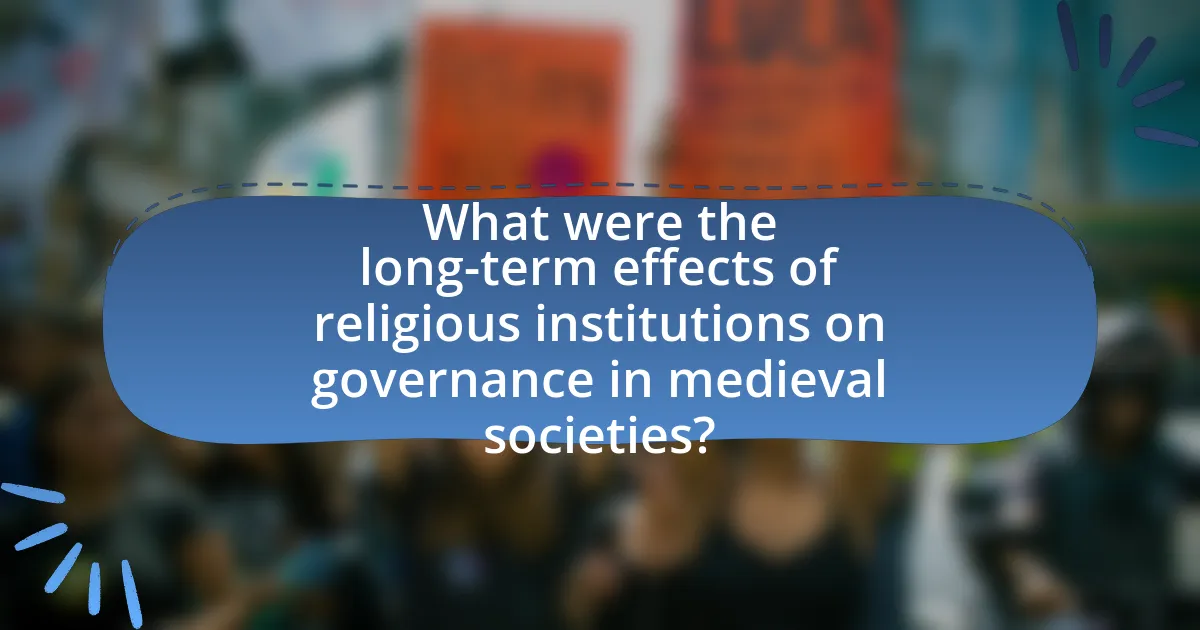
What were the long-term effects of religious institutions on governance in medieval societies?
Religious institutions significantly shaped governance in medieval societies by intertwining spiritual authority with political power. This integration led to the establishment of theocratic systems where church leaders often held substantial political influence, as seen in the Papal States, where the Pope governed both religious and secular matters. Additionally, religious institutions provided a framework for law and order, as canon law influenced civil law, creating a dual legal system that persisted for centuries. The church’s role in education and literacy also contributed to the bureaucratic development of states, as clergy often served as scribes and administrators. This long-term effect solidified the church’s position as a central authority in governance, impacting the evolution of state structures and the relationship between church and state throughout the medieval period.
How did the influence of religious institutions shape modern governance structures?
The influence of religious institutions significantly shaped modern governance structures by establishing foundational legal and ethical frameworks that persist today. Historically, religious authorities often held power that intertwined with political governance, as seen in theocratic systems where religious leaders governed civil affairs, such as in medieval Europe with the Catholic Church’s authority influencing kings and laws. This integration led to the development of concepts like divine right and moral governance, which informed the establishment of modern legal systems and the separation of church and state. For instance, the Magna Carta of 1215, influenced by the Church’s advocacy for justice, laid groundwork for constitutional governance, emphasizing the rule of law over arbitrary power. Thus, the legacy of religious institutions is evident in contemporary governance, where ethical considerations rooted in religious teachings continue to inform laws and civic responsibilities.
What lasting legacies can be traced back to medieval religious governance?
The lasting legacies of medieval religious governance include the establishment of legal frameworks, the integration of moral and ethical standards into law, and the influence on education and scholarship. Medieval religious institutions, particularly the Catholic Church, played a crucial role in shaping legal systems by introducing canon law, which influenced secular laws in many European countries. For example, the principles of justice and equity derived from religious teachings became foundational in the development of common law. Additionally, religious governance promoted the establishment of universities, such as the University of Paris and Oxford, which were initially founded under ecclesiastical authority, thus fostering a culture of learning that persists today. These legacies demonstrate the profound impact of religious governance on contemporary legal and educational systems.
How did the Reformation challenge the established religious governance?
The Reformation challenged established religious governance by promoting the idea of individual interpretation of the Scriptures, which undermined the authority of the Catholic Church. Key figures like Martin Luther argued against the Church’s practices, such as the sale of indulgences, asserting that salvation could be attained through faith alone, as stated in his Ninety-Five Theses in 1517. This shift led to the rise of Protestant denominations that rejected papal authority, thereby fracturing the unity of the Church and diminishing its political power in various regions, notably in Germany and Switzerland. The establishment of state churches in places like England further exemplified this challenge, as monarchs asserted control over religious matters, directly opposing the Church’s governance.
What lessons can contemporary societies learn from the influence of religious institutions in medieval governance?
Contemporary societies can learn the importance of moral authority and social cohesion from the influence of religious institutions in medieval governance. During the medieval period, religious institutions often provided a framework for ethical behavior and community values, which helped maintain order and legitimacy in governance. For example, the Catholic Church wielded significant power, influencing kings and shaping laws, as seen in the Magna Carta of 1215, which established the principle that the king was not above the law, partly due to the Church’s advocacy for justice and rights. This historical context illustrates that integrating ethical considerations and community values into governance can enhance legitimacy and social stability in modern societies.
How can modern governance benefit from understanding historical church-state relationships?
Modern governance can benefit from understanding historical church-state relationships by recognizing the impact of religious authority on political structures and societal norms. Historical examples, such as the Investiture Controversy in the 11th century, illustrate how conflicts between church and state shaped governance, leading to the establishment of clearer boundaries between religious and political powers. This understanding can inform contemporary debates on secularism and the role of religion in public policy, enabling policymakers to navigate the complexities of governance in diverse societies. Additionally, analyzing the historical intertwining of church and state can provide insights into the development of legal frameworks and human rights, as seen in the Magna Carta’s influence on limiting royal power and promoting individual liberties.
What best practices can be derived from the medieval experience of religious influence on governance?
Best practices derived from the medieval experience of religious influence on governance include the establishment of moral authority, the integration of ethical principles into law, and the promotion of social cohesion through shared beliefs. The Church often served as a stabilizing force, providing a framework for justice and community values, which helped to legitimize rulers and their decisions. For instance, the Investiture Controversy highlighted the importance of balancing spiritual and temporal power, demonstrating that governance can benefit from a clear delineation of roles while maintaining mutual respect. Additionally, the use of religious institutions to mediate conflicts and promote peace, as seen in various peace treaties endorsed by the Church, illustrates the effectiveness of religious influence in governance for fostering stability and order.
